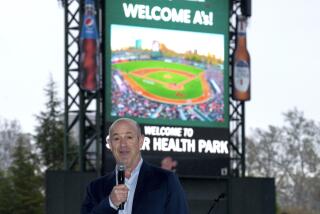Owners Decide to Speed It Up : Baseball: High strike, measures to shorten time of games adopted.
- Share via
BOSTON — Baseball owners on Thursday adopted several recommendations designed to shorten games by half an hour. Angel designated hitter Chili Davis wonders if they’re also trying to shorten his career.
“I’m retiring--I’m gonna go play some softball,” said Davis, who is particularly peeved about a directive for umpires to call the high strike beginning next spring. “You try hitting Roger Clemens or Randy Johnson at the letters. They might never give up a hit.”
Starting July 12, the day after the All-Star game:
--Umpires will prevent batters from routinely stepping out of the box between pitches.
--Breaks between half-innings will be reduced from 2 minutes 25 seconds to 1:45.
--Public address announcers will introduce the first batter of a half-inning 1:15 after the previous out.
Those moves apparently didn’t stir much controversy, but the battle lines were clearly drawn with former umpire Steve Palermo’s three other recommendations that owners adopted but, if approved by the players’ union, won’t go into effect until next season. The league presidents will meet with union lawyer Eugene Orza today.
The recommendations include:
--Raising the mound from 10 inches to 12-13 inches. The mound was lowered from 15 inches to 10 inches after the 1968 season.
--Allowing pitchers to go to their mouths for moisture while they are on the mound.
--Directing umpires to call the “high strike,” the pitch above the waist and below the shoulders that is routinely called a ball. Umpires gradually have shifted away from calling that pitch a strike.
Through Tuesday, the average game time in the major leagues was 3 hours, up 33 minutes from 1978.
“Let’s see, they’ll be able to throw the spitball, they’ll get the high strike, the higher mound will give them a little more leverage,” Angel left fielder Tony Phillips said. “Sounds like they’re trying to get some offense out of the game.”
Pitchers, of course, loved the recommendations.
Said the Angels’ Mark Langston: “Geez, I might be able to play for a little longer.”
Chuck Finley on raising the mound: “Amen to that.”
On going to his mouth on the mound: “Oh, yeah.”
On the high strike: “That’ll work. Widening the plate, that would be good too.”
Finley said pitchers with good curveballs would benefit from a higher mound, and Langston said taller pitchers, such as the 6-foot-10 Johnson and the 6-6 Finley would gain an advantage too.
“The higher mound would be a tremendous advantage for me,” Langston said. “It enables you to get the ball on more of a downward angle, and I feel I can throw harder, get more leverage behind the ball.”
Finley said most pitchers don’t like throwing balls high in the strike zone, “but anything that makes a batter think more is going to give an advantage to the pitcher.”
Angel reliever Lee Smith, who is known for his leisurely strolls from the bullpen to the mound, had mixed feelings about the measures.
“That’s trouble--that’s probably not enough time for me,” Smith said of the 1:45 limit between innings. “I ain’t gonna change anything. They can sue me and take it out of my December check. But I like that high strike. I’ll run out there if we get something like that.”
Finley had little sympathy for batters.
“Hey, get a tee,” he said. “We’re not putting them at a disadvantage. We’re just trying to speed up the game. When you get a 3-2 game that takes 3 hours 20 minutes, you say, ‘What’s going on?’ You see the stands emptying by the sixth inning. They’re going to sleep.”
More to Read
Go beyond the scoreboard
Get the latest on L.A.'s teams in the daily Sports Report newsletter.
You may occasionally receive promotional content from the Los Angeles Times.








